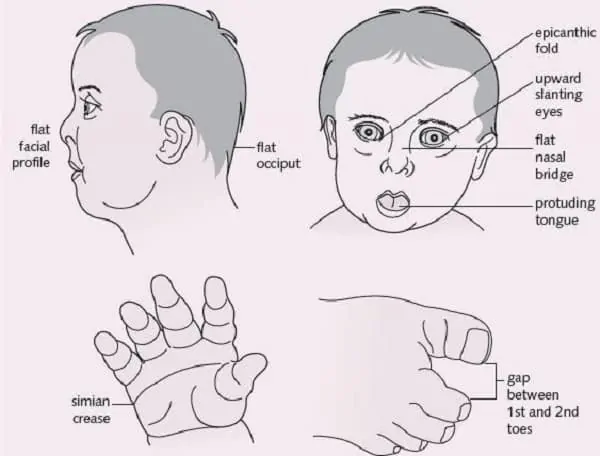
- Definition: Genetic disorder caused by a trisomy in one of the chromosome pairs
- Cause: A partial or full third copy of chromosome 21
- Name: Named after the British doctor John Langdon Down
- Types: Trisomy 21, translocation, mosaicism
- Life Expectancy: Twice as long as 30 years ago
- Population: All races, all economic levels
- Treatment: Physical, occupational, emotional, behavioral and speech therapies
- Statistics: Approximately 1 in 1000 babies
- Diagnosis: Before birth, after birth
- Awareness: 21 March – World Down Syndrome Day
- Origin: The Condition Has Been Present for Centuries, but Known Only since the 19th Century
- Symptoms: The Condition Can Be Recognized by Various Physical and Mental Signs
- Diagnosis: Screening Tests and Diagnostic Tests Are Used for Detecting the Condition
- Consequences: Down Syndrome Brings Health Risks, Including Heart Disease, Obesity and Cancer
- Treatment: Down Syndrome is Incurable, but Treatable
- Statistics: Approximately 1 in 700 to 800 Babies in the USA is Born with Down Syndrome
- Heredity: Down Syndrome is Hereditary, but Only in 1% of Cases
- Prevention: Down Syndrome Can’t be Prevented, but 3 Major Risk Factors Are Known
- Statistics:2/3 of US Women Decide to have an Abortion Once Diagnosis Is Made
- Future: Research Focuses on How the Extra Material in Chromosome 21 Causes the Disease
- Individuals with Down Syndrome Nowadays Often Live to 50 or 60
- Trisomy 21 (Nondisjunction) is the Most Common Type of Down Syndrome
- 20% of Individuals with Down Syndrome in the US have Jobs
- 80% of Children with Down Syndrome are Born to Women Under 35
- Breaking the Myth: People with Down Syndrome are Always Happy
- Chris Burke is an Exceptional Example of What People with Down Syndrome Can Achieve
- 5,000 to 6,000 Children with Down Syndrome Are Born in the USA Each Year
- People with Down Syndrome Can Have Children
The Condition Has Been Present for Centuries, but Known Only since the 19th Century
There is no historical Down syndrome facts documentation that would shed a light on the origins of the Down syndrome, but persons with it are believed to be portrayed in different kinds of art for centuries, although the condition was considered just a mental disability until the 19th century. Down syndrome was first recognized as a special, separate condition in 1862, but it was not until 1959 that its cause – the extra chromosome – was discovered. At that time, the condition also became known by the name trisomy 21.
The Condition Can Be Recognized by Various Physical and Mental Signs

Physical characteristics of those who have Down syndrome include a flattened face (especially the nose), slanted eyes, a short and thick neck, small ears, hands and feet, a large tongue that partially sticks out of the mouth, irregular and crooked teeth, a flat head, stunted growth, a wider gap between the first and second toe, low muscle tone and a single palmar crease.
There are also signs of mental disability, which typically limits individuals with Down syndrome to an IQ of 35 – 70, speech problems and possible mental illness, depression, anxiety and, in 10%, autism.
Screening Tests and Diagnostic Tests Are Used for Detecting the Condition
Screening tests for discovering Down syndrome are nowadays offered to all pregnant women and can be done in the form of a combined test (blood test plus ultrasound), integrated screening test, quad screen or cell-free fetal DNA. There are also several diagnostic tests that can be used prior to birth: amniocentesis, chorionic villus sampling (CVS) and cordocentesis.
After birth, the diagnosis is made based on the baby’s appearance and later confirmed with a chromosomal karyotype test.
Down Syndrome Brings Health Risks, Including Heart Disease, Obesity and Cancer
In addition to congenital heart disease, leukemia, testicular cancer and obesity, individuals with Down syndrome generally have an increased chance of getting various kinds of infectious diseases (due to abnormalities of the immune system), dementia, sleep apnea, seizures, ear infections, thyroid gland problems, diabetes, constipation, fertility problems, vision loss and hearing problems.
Down Syndrome is Incurable, but Treatable
One of the most tragic Down syndrome facts is that the condition is unfortunately incurable, but its symptoms can be treated, which eases and prolongs the lives of those who suffer from the condition. Some patients and their caretakers decide to remove some of the obvious physical symptoms with plastic surgery, and most of them partake in various kinds of therapy that help them reach their full intellectual potential and become normally functioning members of society when they reach adulthood.
Various kinds of medications are used in treating health problems connected to the condition; some people also believe that utilizing alternative approaches, such as animal therapy, chiropractic treatments, naturopathy, massage or special diets, helps manage the condition.
Approximately 1 in 700 to 800 Babies in the USA is Born with Down Syndrome

That makes USA slightly above the worldwide average, which is estimated at 0.1% of the population. There are approximately 400,000 individuals with this condition living in the USA today, but the number is expected to grow, since advancements in the medical field enable patients with this condition to live longer and longer.
Down Syndrome is Hereditary, but Only in 1% of Cases
Among all three types of Down syndrome (trisomy 21, translocation and mosaicism), only translocation is hereditary in one third of all cases, meaning that the syndrome overall is hereditary in only 1% of all instances. However, Down syndrome facts show that women who have had one child with Down syndrome are approximately 10 times more likely to have another baby with this condition compared to other women. That makes their chances of having another child with Down syndrome around 1%.
Down Syndrome Can’t be Prevented, but 3 Major Risk Factors Are Known
Although Down syndrome can’t be prevented no matter how early it is be diagnosed (or predicted), three major risk factors have been identified through decades of research: high maternal age, previous children with Down syndrome and genetic translocation heredity.
Genetic translocation presence and having previous children with the condition each increase the chance to 1%, and the risk connected with mother’s age depends on the actual age. The chances of having a child with Down syndrome are approximately 0.07% for women at 20, 0.1% at 30, 1% at 40, and around 2 – 3% for women at 45 – 50. The father’s age also has a minor impact on the probability, but only if the mother is older than 35.
2/3 of US Women Decide to have an Abortion Once Diagnosis Is Made
Although there are still countless debates on the morality of abortion nowadays, almost 70% of US women choose this option once the diagnosis of Down syndrome is made. In Europe, the share is even higher: 92%. It is interesting to note that the probability of deciding to have an abortion steeply rises as an actual diagnosis draws nearer. Only 23 – 33% of people who are not actually expecting a child say they would decide to have an abortion in the case of Down syndrome being diagnosed, but the share rises to 46 – 86% in pregnant, high-risk women and to 89 – 97% in women who are actually screened positive for the condition.
Research Focuses on How the Extra Material in Chromosome 21 Causes the Disease
This is because we still don’t know why or how the third chromosome in the chromosome pair 21 causes the syndrome and all its negative health consequences. The other big branch of research in the field focuses on using stem cells to improve the intelligence (and consequently the quality of life) of those affected by the condition.
Individuals with Down Syndrome Nowadays Often Live to 50 or 60
Down syndrome facts reveal that 100 years ago, most people with Down syndrome didn’t live beyond 10 or 12 years, but advancements in medicine over the decades have improved their life span greatly – in the 1980s it was about 25 years, and nowadays a lot of individuals with this condition live to 50 or 60 years. Expected lifespan depends greatly on the presence of congenial heart disease. Some 60% of those who have it survive beyond 10 years, and 50% beyond 30 years; among those who are lucky to avoid it, 80% survive beyond 30 and 10% even beyond 70 years.
Trisomy 21 (Nondisjunction) is the Most Common Type of Down Syndrome
Around 95% of those who have Down syndrome have the trisomy (nondisjunction) type of the condition, which is marked by a full third chromosome of the 21st chromosome pair. This type is not hereditary. The other two types, translocation and mosaicism, are present only in 4% and 1% of cases, respectively.
20% of Individuals with Down Syndrome in the US have Jobs

In Europe, the share of those who work regularly for money is much lower – just 1% – but many attend (and finish) regular schools, learn to read and write, have a rich social life, and manage to live very fulfilling lives with little help from others. Some 40% of those who attend high school in the USA also finish it, and the success rate is usually even higher with those who have the mosaicism type of the condition.
80% of Children with Down Syndrome are Born to Women Under 35
How is that possible when we know from other Down syndrome facts that the probability of babies having Down syndrome increases with their mother’s age? Simply because the fertility rate is much greater in younger women, and the majority of women give birth before they are 35…
Breaking the Myth: People with Down Syndrome are Always Happy
Of course they are not always happy! They have normal feelings just like the rest of us. They can be hurt, sad, nervous or angry, but since most of them only reach the intellectual and emotional level of pre-pubescent children, they might often indeed appear happier than most adults…
Chris Burke is an Exceptional Example of What People with Down Syndrome Can Achieve
Chris Burke is probably one of the most well-known people with Down syndrome in the USA today. Nearing his 50s and still inspiring people across the country, Chris has done it all! He has had a leading role in a TV show called Life Goes On in the early 1990s, appeared in various other TV productions, including the famous North and South miniseries and multiple award-winning series ER, co-wrote his autobiography, worked as an editor-in-chief for Down syndrome publications and traveled the world increasing awareness about the condition and raising the spirits of all those who suffer from it.
5,000 to 6,000 Children with Down Syndrome Are Born in the USA Each Year
Despite the high abortion rate, there are still thousands of children with Down syndrome born each year. It is estimated that the condition affects roughly 1 in 4 US families in one way or another.
People with Down Syndrome Can Have Children
It is a common myth that all those who have Down syndrome are infertile, but it is not true – the fertility rate is low, but there have been several cases of men and women with Down syndrome having children. Men with this condition usually really are infertile and only a few individuals have been known to father a child, but women with Down syndrome are fertile in 30% to 50% of cases. The chance of a child having the syndrome if one parent has it is roughly 50%, but can be decreased with the help of modern genetic technology.
Down Syndrome Facts — Facts about Down Syndrome Summary
 Down syndrome is the most common genetic disease in the world, caused by a partial or a full presence of a third chromosome in the chromosome pair 21. It was discovered in the mid-1800s by a British doctor, from whom it also got its name. Typical symptoms include a flattened face, slanted eyes, a short and thick neck, a large tongue that partially sticks out of the mouth, irregular and crooked teeth, stunted growth, low muscle tone and mental disabilities. Individuals with Down syndrome suffer from various health problems, but modern medicine enables them to overcome these issues and live healthy and fulfilling lives, often reaching 50 or 60 years of age.
Down syndrome is the most common genetic disease in the world, caused by a partial or a full presence of a third chromosome in the chromosome pair 21. It was discovered in the mid-1800s by a British doctor, from whom it also got its name. Typical symptoms include a flattened face, slanted eyes, a short and thick neck, a large tongue that partially sticks out of the mouth, irregular and crooked teeth, stunted growth, low muscle tone and mental disabilities. Individuals with Down syndrome suffer from various health problems, but modern medicine enables them to overcome these issues and live healthy and fulfilling lives, often reaching 50 or 60 years of age.
Was this page helpful?
Our commitment to delivering trustworthy and engaging content is at the heart of what we do. Each fact on our site is contributed by real users like you, bringing a wealth of diverse insights and information. To ensure the highest standards of accuracy and reliability, our dedicated editors meticulously review each submission. This process guarantees that the facts we share are not only fascinating but also credible. Trust in our commitment to quality and authenticity as you explore and learn with us.
